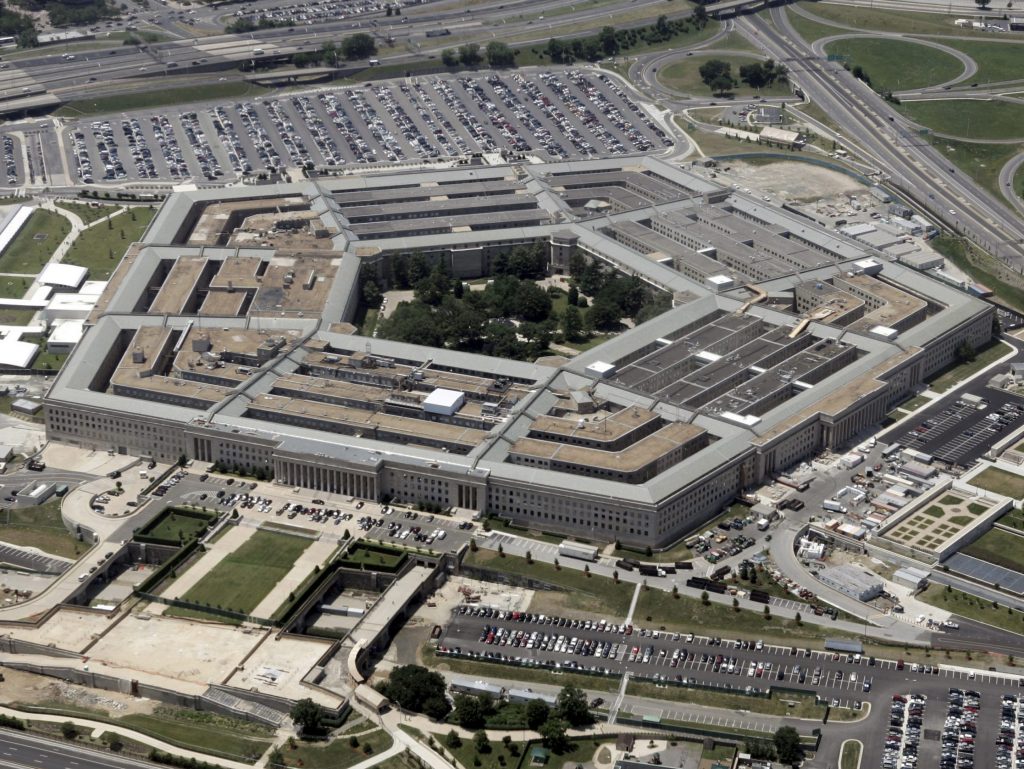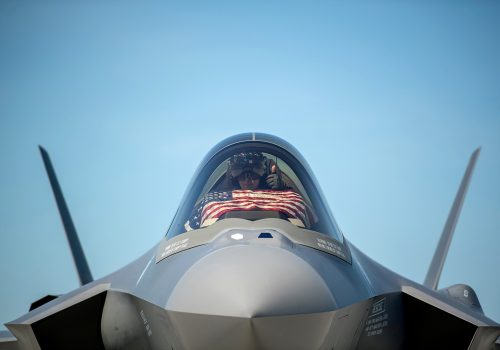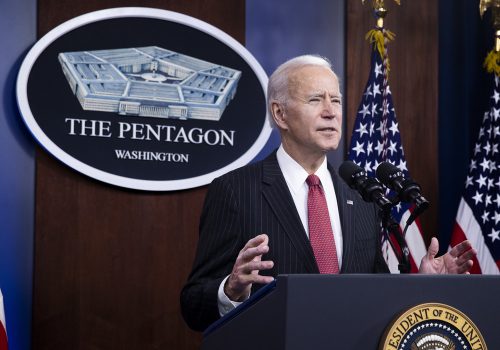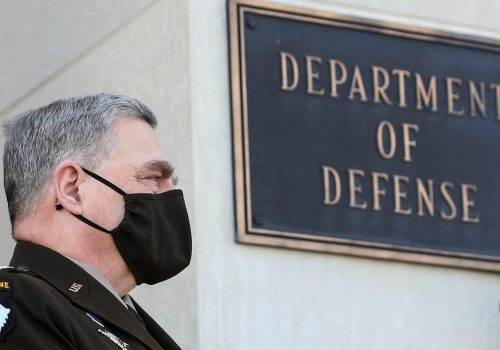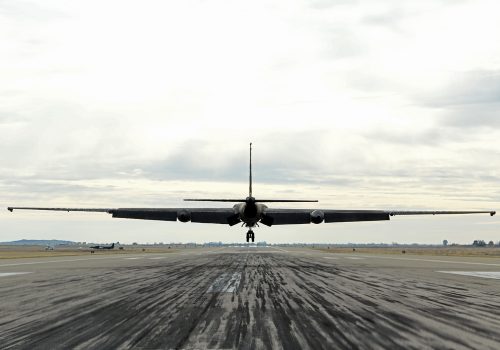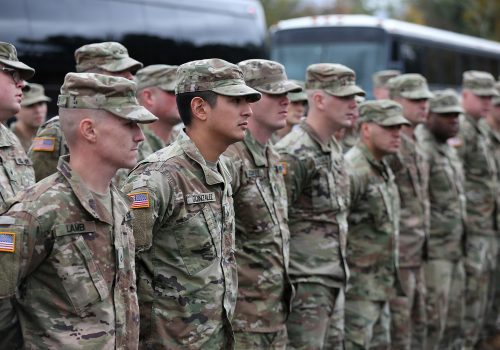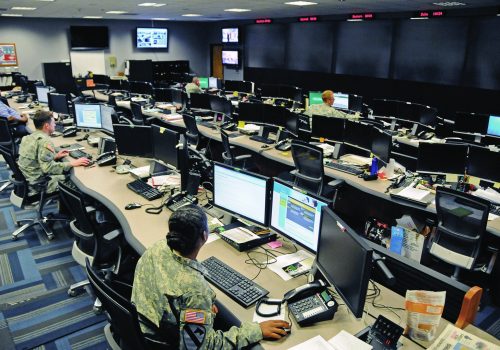Seizing the advantage: A vision for the next US national defense strategy
FORWARD DEFENSE
STRATEGY PAPER LAUNCH
The Department of Defense’s National Defense Strategy (NDS), to be published in early 2022, is one of the most important documents the Biden administration will produce. As the United States confronts a range of multifaceted and simultaneous security challenges, the 2022 NDS will provide a blueprint for navigating these threats and revitalizing US global leadership.
In this latest installment of the Atlantic Council Strategy Papers series, Forward Defense’s authors articulate their vision and recommendations for the next NDS, including clearer prioritization, investments and divestments, reposturing of US forces, and a focus on transnational threats like climate change and hybrid conflict.
The nation must tackle a new reality, developing the next strategy to secure the United States and the world. This paper…—Seizing the Advantage: A Vision for the Next US National Defense Strategy—is a thoughtful, realistic, and relevant answer to some of our most difficult challenges.”
Secretary Chuck Hagel, 24th Secretary of Defense
Executive summary
The challenge
The 2018 National Defense Strategy (NDS) recognized the rapidly changing global security environment, including the rise of strategic competition with China and Russia. It also refocused the Department of Defense (DoD) from what had been its primary mission—counterterrorism and counterinsurgency—to competition with those two nations:
We are facing increased global disorder, characterized by decline in the long-standing rules-based international order—creating a security environment more complex and volatile than any we have experienced in recent memory. Inter-state strategic competition, not terrorism, is now the primary concern in U.S. national security.”
Department of Defense, Summary of the 2018 National Defense Strategy of the United States of America
As the Biden administration prepares to release its NDS, the modern challenges facing the United States have continued to evolve, and the risks to the United States, its interests, and those of its allies and partners are more pronounced than even four years ago. China has continued to modernize its military at shocking speed, building the world’s largest navy, operationally deploying stealth fighters, planning to increase its nuclear warhead stockpile by as much as four times, and rapidly integrating a variety of emerging military and dual-use technologies like hypersonic weapons and artificial intelligence.1Matthew Kroenig, “China’s stunning military buildup,” Fast Thinking, November 4, 2021, https://www.atlanticcouncil.org/content-series/fastthinking/fast-thinking-chinas-stunning-military-buildup/;Matthew Kroenig and Christian Trotti, “What to do about China’s hypersonic weapons,” Fast Thinking, October 18, 2021, https://www.atlanticcouncil.org/content-series/fastthinking/fast-thinking-what-to-do-about-chinas-hypersonic-weapons/ Russia, despite economic challenges, continues to invest in a new generation of strategic weapons, including new nuclear delivery vehicles.2Matthew Kroenig, Mark J. Massa, and Christian Trotti, “Russia’s Exotic Nuclear Weapons and Implications for the United States and NATO,” Atlantic Council, March 6, 2020, https://www.atlanticcouncil.org/in-depth-research-reports/issue-brief/russias-exotic-nuclear-weapons-and-implications-for-the-united-states-and-nato/ China and Russia are also increasing their illicit hybrid conflict activities, flouting accepted international rules and norms. Regional aggressors Iran and North Korea continue to conduct malign activities and support destructive actors and proxies. Violent extremist organizations (VEOs) still pose a major threat to the homeland and US interests abroad. Finally, transnational issues such as climate change and global pandemics will pose increasingly grave threats to the security of the United States and test the readiness of the US military.
Great-power games
It has become fashionable to denigrate the United States’ grand strategy, or lack thereof, as America playing chess, a defined and linear game, with the goal of attriting the adversary’s forces and capturing their king. This analogy postulates China as playing Weiqi (or “Go”), a complex game with many more possible moves and strategies, with the aim of outpositioning and surrounding the adversary, presenting various faits accomplis, and forcing a surrender with limited combat.1Timothy J. Demy, James Giordano, and Gina Granados Palmer, “Chess vs Go – Strategic Strength, Gamecraft and China,” National Defense Magazine, July 8, 2021, https://www.nationaldefensemagazine.org/articles/2021/7/8/chess-vs-go—strategic-strength-gamecraft-and-china; Lieutenant Colonel Christopher P. Mulder, “Let’s ‘Go’ Back to the Basics to Counter China,” DoDReads, July 26, 2021, https://www.dodreads.com/lets-go-back-to-the-basics-to-counter-china/. In this analogy, the deployment of the Chinese hybrid tool set around the world, including the Belt and Road Initiative, political warfare, and the buildup of military and paramilitary forces, could be seen as evidence of China’s attempt to move its stones on the global Go board to encircle the United States, thereby marginalizing the “declining” power as China retakes its position as the “Middle Kingdom.”2Suzanne Ho, “How China is beating the US in geopolitical board game,” letters, South China Morning Post, January 31, 2021, https://www.scmp.com/comment/letters/article/3119753/how-china-beating-us-geopolitical-board-game. For more than two thousand years, China has seen itself as the Middle Kingdom, the center of the world not just geographically, but culturally, politically, and economically, according to the Council on Foreign Relations (CFR). Council on Foreign Relations, China’s Approach to Global Governance, https://www.cfr.org/china-global-governance/. According to CFR, China is looking to reestablish its position as the Middle Kingdom after more than two centuries of marginalization.
Seizing the Advantage rejects the premise of this geopolitical board game analogy because the real “game” is neither chess nor Go. Chess is too oriented toward military attrition and Go involves an overly simple and symmetrical toolset of equally capable stones—but the greatest flaw of the analogy is that both of these games are defined by clear rules that the players must follow. In the real world, the players can decide whether and when to play by the existing rules on the existing gameboard or develop entirely new ones. Therefore, Seizing the Advantage encourages the US government to take a four-dimensional view of strategic competition with China (and Russia)—one defined by geography, time, different domains, and the competition continuum as its axes.3For more information on the competition continuum, see Chapter 3 of this report. The United States needs to redefine the geopolitical “game” in ways that better integrate and maximize its existing advantages, such as its robust web of alliances and partnerships, its strong economic fundamentals, its long history of military and defense-industrial prowess, and the benefits of its democratic model. Only a new game, crafted intentionally and strategically, has the potential to halt its perceived decline and take the offensive against its competitors with the goal of improving its relative security position and revitalizing the international rules-based order.
Alone, these challenges are daunting; together, they have begun to put at risk US global power and prestige. In a world of accelerating multipolarity and strategic simultaneity, China and Russia are each attempting to remake or disrupt the international order in ways that better suit their respective national interests, and the United States’ ability to deter, prevent, and rollback these transgressions will continue to diminish without immediate action. The imperative is clear: US policymakers need to arrest the relative or perceived decline of American power and present a roadmap to rebuild the United States’ standing in the world, primarily by hewing more closely to core US interests; shoring up alliances; and by maximizing, integrating, and building upon existing, but too often disparate and uncoordinated, US advantages. Indeed, if the geopolitical game is changing, pushed by competitors who manipulate the rules in their favor, it would be a critical failure to not adapt and to continue to allow adversaries to play a different game. Instead, the United States, with allies and partners, must change the game and reshape the environment in their favor.
The imperative is clear: US policymakers need to arrest the relative or perceived decline of American power and present a roadmap to rebuild the United States’ standing in the world.
Clementine G. Starling, Tyson K. Wetzel, and Christian S. Trotti
A bold vision
This complex and dynamic security environment provides the context for Seizing the Advantage: A Vision for the Next US National Defense Strategy. This strategy offers solutions for the DoD to consider as it formulates its next NDS. The next NDS should provide clear and achievable national defense goals and subsidiary objectives in line with core interests, while establishing actionable lines of effort and implementation guidelines to ensure that the DoD supports the greater national security strategy as outlined by US President Joseph R. Biden, Jr. to “[p]romote a favorable distribution of power to deter and prevent adversaries from directly threatening the United States and our allies, inhibiting access to the global commons, or dominating key regions.”3“Interim National Security Strategic Guidance,” White House, March 2021, 9, https://www.whitehouse.gov/wp-content/uploads/2021/03/NSC-1v2.pdf
Seizing the Advantage lays out a bold vision to improve the United States’ relative security position through the following lines of effort: 1) adapting to the “new competition” by confronting Chinese and Russian hybrid conflict efforts and taking the offensive in the gray zone; 2) preparing for the “new battlefield” by remaking the force to better deter and dominate future conflict; 3) leveraging “new and established friends” by building and revitalizing defense relationships globally; and 4) crafting the “new enterprise” by training, equipping, and securing the department for technological superiority. Through these efforts, the United States must strive toward a new “game” that embraces a paradigm of strategic competition as a continuum from cooperation through armed conflict, where the various instruments of national power are removed from their silos and are more linkable, scalable, and usable than ever before. By forcing adversaries to play on this gameboard, by these rules, the United States can once again “seize the advantage.”
Four key proposals
The authors present four key proposals, cutting across the strategy’s lines of effort and guidelines of implementation, that will enhance the United States’ efforts to compete now, strengthen deterrence, integrate allies and partners into a latticed defense structure, and build a force that can dominate future armed conflict should the need arise.
- The DoD needs to compete now and engage in offensive hybrid conflict actions. The United States must respond where competition with China and Russia is taking place today, primarily by playing an enhanced role in gray-zone competition. Accordingly, the Pentagon must embrace the paradigm of competition as a continuum from cooperation through competition to armed conflict. But embracing the continuum is not enough; the DoD, working with interagency partners where appropriate, must defend more aggressively and take offensive actions in the gray zone, consistent with American values. Seizing the Advantage articulates the concept of a competition continuum and advances recommendations for the DoD to shape the information environment and compete in cyberspace.
- Future warfighting must be joint, combined, and across all domains. Conflict in the future will require better integration of all US military services and will take place on land, at sea, in air, space, and cyberspace, and across the electromagnetic spectrum. It must also be conducted in close coordination with allies and partners, who collectively comprise one of the United States’ greatest advantages vis-à-vis its major-power competitors. A new operational concept that embraces this future battlefield is necessary. Seizing the Advantage introduces the “Combined Warfighting Concept” (CWC), an all-domain, joint, and combined warfighting concept that embraces the role, capabilities, and capacity of allies and partners from the start.
- The DoD must build the force to dominate armed conflict of the future. The future battlefield will be data-centric, networked, and fast-paced. Both the United States and its strategic competitors are heavily investing in revolutionary kinetic and non-kinetic weapons, including hypersonic delivery vehicles, autonomous combat systems, directed energy, and cyber tools. While these weapons will make it easier to neutralize or destroy targets, finding those targets will be the more pressing challenge. Therefore wars of the future are likely to be won by the side that can best harness available data across all domains and deny the adversary the ability to do the same. Seizing the Advantage articulates clear investment priorities to build that force—and divestment priorities to afford it.
- The DoD must rebalance its force posture from Central Command-centric to a more globally oriented model. As the United States shifts its overall focus from counterterrorism to strategic competition, its global force posture must shift accordingly. The era of numerous, long rotational deployments to the Central Command Area of Responsibility is over. As an alternative, Seizing the Advantage introduces a balanced, differentiated, “latticed” posture model that would move needed asset types to the Indo-Pacific and Europe, and rely on a more tightly linked defense structure with allies and partners, thereby mitigating risk from the US rebalance.
Strategy Paper Editorial board
Executive editors
Mr. Frederick Kempe
Dr. Alexander V. Mirtchev
Editor-in-chief
Mr. Barry Pavel
Managing Editor
Dr. Matthew Kroenig
Editorial board members
Gen. James L. Jones
Mr. Odeh Aburdene
Amb. Paula Dobriansky
Mr. Stephen J. Hadley
Ms. Jane Holl Lute
Ms. Ginny Mulberger
Gen. Arnold Punaro
Watch the event
Lead authors
Contributors
Explore our Seizing the Advantage project

Related analysis on defense policy
Subscribe
Sign up for updates from Forward Defense to hear the latest on the trends, technologies, and military challenges shaping tomorrow.

Forward Defense, housed within the Scowcroft Center for Strategy and Security, generates ideas and connects stakeholders in the defense ecosystem to promote an enduring military advantage for the United States, its allies, and partners. Our work identifies the defense strategies, capabilities, and resources the United States needs to deter and, if necessary, prevail in future conflict.
Image: "Aelbert Cuyp, The Maas at Dordrecht, c. 1650, oil on canvas, overall: 114.9 x 170.2 cm (45 1/4 x 67 in.) framed: 151.1 x 205.1 x 15.2 cm (59 1/2 x 80 3/4 x 6 in.), Andrew W. Mellon Collection, 1940.2.1" Source: Wikimedia Commons, https://commons.wikimedia.org/wiki/File:Aelbert_Cuyp_-_The_Maas_at_Dordrecht_-_Google_Art_Project.jpg
